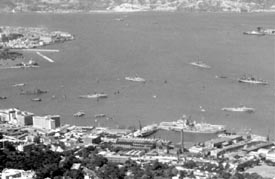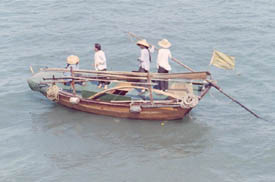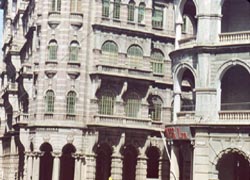
Wanchai District, Hong Kong - 1957 |
Returning to Hong Kong again in 1957, after spending three months there as a station ship in 1956, was like coming home again -- somewhat that is. It's a fascinating city, was in the 1950's and is even more so today. But it definitely wasn't home. No doubt some of the crew was excited to be returning, but I doubt that feeling was shared by everyone, me included.
Hong Kong is a huge metropolis today, with little resemblance to the what we saw and experienced while aboard the Spangler. The photo above of the Wanchai District of Hong Kong was borrowed with permission from Harry Stuff, a British author well known for his writings on the the Middle East, and Africa. I strongly encourage you to pause here for a moment and visit his website: Harry's Stuff -- Hong Kong and Kowloon in the 1950's.

Phil Eng's Snapshot of Hong Kong Harbor - 1957
What we did there as station ship in 1956 I haven't the slightest idea, but I do know we spent a lot of time observing foreign ships coming in and out of the harbor. Maybe we played some other military roll, but as a lowly seaman at the time I wasn't privy to that information. My job was to stand watch a few hours every day and photograph ships coming in and going out. I recall one ship that left and came back a few days later shot to hell. I often wondered if any of my photographs taken earlier played a roll in that. The camera was one of those large boxy style cameras you see in World War II airplanes.
Hong Kong in those days had three faces: the beautiful well-maintained British sector on the west side of the city, the Chinese sector on the eastern side, and the Kowloon (Communist China) sector across the bay.
We no sooner dropped anchor and we were surrounded by small junks begging for food and offering cleaning services. Well known to the navy among them was Mary Soo, Hong Kong's garbage queen. In the photos below, she's the one not handling the oars. These three photos of the Junk and of Mary Soo and her side cleaners (in fact all the color photographs shown here with the exception of those from the 1985 revisit to Hong Kong) were recently made available to the website, thanks to Phil Eng (IC2 - USS Spangler 1954-1957).
 Fishing Boat in Hong Kong Harbor Fishing Boat in Hong Kong Harbor |
 |
 |
Mary Soo and Her Side Cleaners
Mary Soo and her cleaning girls have been a fixture for navy ships anchoring in Hong Kong for years. She and her helpers would be there as soon as the anchor hit the water to arrange a cleaning deal. Depending on how long your ship would be there, this could mean cleaning the ship from stem to stern in exchange for the garbage and leftovers from the crew's mess. Her efforts also included painting and scrubbing all woodwork, if she could talk the Captain into it. Presumably she would sell the leftovers to the less fortunate in Hong Kong. For a wonderful closeup photo of Mary Soo and her girls at work please pause here for a moment and visit the USS Yorktown's webpage on side cleaners in Hong Kong.
Possibly you caught Phil Eng's note in the SeaTales section in which he tells of the role he played in getting Mary Soo and her girls to clean the wooden grid platform on the flying bridge. This was back in '56. Not only would she clean it but refinished it as well. Phil says, "Guess what I did. I pulled all the phone outlet cover plates, all electrical plates,the brass door handle to the I.C. room, and some other stuff, and had her chrome plate it all. Cost me six bucks! Next inspection the skipper went ape1 Who paid for this, he asked? I did I said! He loved it! I mean he really loved that I would do this out of my own pocket. What no one knew was that I didn't know that Mary Soo was going to charge me. On the last day before we sailed I asked her where all my stuff was. She said you owe me six dollar U.S. If you recall we were paid in script there. Man, I had to do a mad scramble to get six bucks together fast, or I would have been in Deep Shit!"
Kowloon, sitting across the harbor from Hong Kong, was part of Communist China at least that's what I was led to believe at the time.) Anyway, it was off limits to us. This was also true of the area on the other side of Queen Street in Hong Kong because of the migration of people from Communist China into that area. We were free to roam the British Sector and all the shops, bars and clubs along Queen Street. But that was about it! Moreover when we went ashore we were only permitted "Cinderella Liberty," which meant we had to be back aboard ship by midnight.
As to liberty in Hong Kong, to be frank, I didnít care much for it. For one it was too crowded and noisy and second, I tended to be a little more partial to the Japanese girls. Of course that's a matter of personal preference, others would likely see it differently. You walk into a bar in Japan and the girls hugged your neck, you walk into one in Hong Kong and they grabbed you by the crotch and pulled you all the way to a table somewhere in the back of the bar. That was rough!
Going ashore in Hong Kong as I recall was a bit of a hassle, unlike Yokosuka, we only had the one liberty boat for transportation and it didnít run too often and was typically crowded when it did. Most of the time when I went ashore I spent my time walking around in the British sector shopping and sightseeing. The Brits had an outstanding Servicemanís Club and those people were crazy, so it was fun just watching them.
The frequency with which people committed suicide in the Harbor was sad!. Of course we weren't in Hong Kong long enough in '57 to notice it as much. But during our three month stay in '56 I donít think a night went by when we didnít hear the sirens blasting off from a ferry crossing from Kowloon to Hong Kong, indicating that someone had jumped overboard. And every now and then someone on our ship would discover a body floating by. One even got caught in our gangway, as I recall.

Hong Kong to Kowloon Ferry
Source: James Sims SN (1952-1956) |
Sanpans, the small Chinese fishing boats, were everywhere. Thousands of them! The far end of Hong Kong Bay was called Sanpan City. One could literally walk a mile or two across sanpans without ever stepping ashore. Phil Eng managed to to get around the city and and captured a little of the scenery.

Sanpan - Common Sight in 50's
| 
Sanpan City |

Hong Kong Post Office |

Tiger Head - Tiger Balm Garden |

Hong Kong Skyline |

Long Pavilion - Tiger Balm Garden |

Hong Kong Double Decker Bus |

Tiger Balm Garden |
Ok, that's enough on Hong Kong! We departed there on April 13th heading toward Formosa anchoring in Keoshung the 14th. Just as a note of interest, here's how much Hong Kong had changed by the time my wife, daughter and I were there in 1985. Click on any one of the three photos to see an enlargement. Be sure to use your browsers back button to return.
1985 Revisit To Hong Kong
 |
 |
 |
|
|